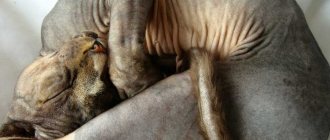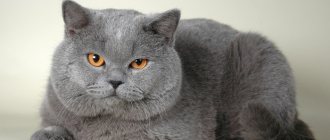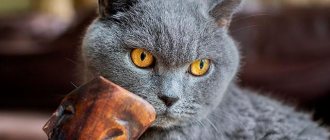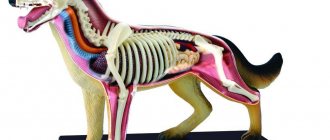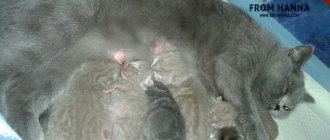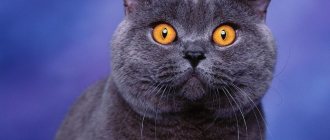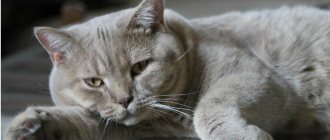- Pets
- >>
- Cat breeds
* Here is a photo of a typical representative of the British Shorthair cat breed . You can send us photos of your animals by email, and we will post them on the website. Don't forget to send your pet's name.
Video
* We invite you to watch a video about the British Shorthair cat . In fact, in front of you is a playlist in which you can select and watch any of 20 videos about a given cat breed by simply clicking on the button in the upper right corner of the window. In addition, the material contains quite a lot of photos. By looking at them you can find out what a British Shorthair cat looks like.
In this article:
|
History of the origin of British Shorthair cats
Representatives of felinology still cannot agree on the origin of British cats.
Today there are two main versions, each of which has its own list of supporters:
- France. Many felinologists believe that the history of the British is closely connected with their fellow French - the Chartreuse cat breed. According to scientists, representatives of these groups were brought to Europe from Africa at approximately the same time. The new breed was first bred by monks. Cats came to Britain through ships, where they served as rat catchers. This theory is confirmed by the similarity between the British and the Chartreuse;
- Rome. Delving into history, you can find interesting facts about the conquest of Britain by Rome. It is with this event, according to felinology scientists, that the emergence of this breed on British soil is connected. Felinologists believe that the Romans brought Roman cats to Britain, which, in turn, quickly adapted to the new land and were loved by its settlers. This version of origin is confirmed by numerous mass graves of cats that were discovered by archaeologists in Britain.
Only one thing can be said with certainty: the real history of cats began in Britain. It is here that the earliest depictions of British Shorthairs were discovered, dating back to around the 700s. Small pictures of animals were applied to colored miniatures.
Interesting fact: There were images of representatives of this breed in books. So, in the 800s, in a handwritten book, one of the Irish monks drew a British shorthair cat and wrote that such an animal really brightens up the monastic everyday life, making them more interesting.
In the 10th century, the cult of the British only increased. At this time, the Celtic sculptor, when creating a stone cross with scenes from the Passion of Christ, did not forget to add cats. One had a small kitten in his paws, and the other had a chick. Around the same time, a law was passed in Britain to protect cats. Representatives of this breed were very expensive.
British Shorthair cat - description of the breed
British shorthair cats are the most ancient representatives of large cats. The original name of the breed was “British Blue”. This is due to the peculiarity of the pet’s iridescent color. The new name is also associated with wool, only this time not with color, but with length: “Shorthair”.
The British are quite strong and robust pets, characterized by medium and large dimensions.
The main descriptive features of the body structure are:
- Round head, widened at the cheekbones. The neck of cats is very thick (almost invisible), but at the same time short;
- Expressive muzzle. The nose is short and straight. He is vertical with a strong chin;
- Big eyes. The look is one of the main characteristics of the British. The eyes of these cats are large, wide open and set far apart. They can be orange or blue. The shade of the eyes depends on the color of the animal;
- Squat body. The body of the animals is straight, the back is short, and the shoulders are massive;
- Short legs. At the same time, cats’ paws are very strong and large;
- Thick tail. This part of the cat's body is not very long. The tail is rounded at the end;
- Thick and short fur. The most important feature of animals of this breed. The British coat is shiny, medium soft/hard and has a dense texture.
In general, representatives of the British Shorthair look very attractive and graceful. It was their appearance that became the reason for the increased love for them from people. What attracts most about the British is their look and fluffy big cheeks, which children love to squeeze.
Average whole adult: 6-9 kg (males) and 4-6 kg (females). Height at the withers is 28-33 cm. The life expectancy of pets is 15-20 years. This period largely depends on the Briton’s habitat, conditions of detention, nutrition and treatment. Animals need regular vaccinations and a special menu. Moreover, they can be kept both indoors and outdoors.
British vs Scots
The British plush kitten should in no case be confused with the Scottish one. Britons are massive, large animals with short legs and a thick tail. The Scottish kitten will grow up to be thinner-legged, its tail will be longer, and its cheeks will be much smaller. The British Shorthair is a purebred, naturally healthy, moderately aggressive cat breed that has retained all its hunting skills, and the shorthaired plush Scots are the product of the genetic efforts of lovers of a soft and fluffy bundle of warmth in their arms.
The short-haired plush Scottish cat is completely devoid of aggression at the genetic level, she does not know how to hunt and is unlikely to survive if she gets lost on the streets of the city. Scottish cats are distinguished by their affectionateness, sociability, even tenderness; they get along with everyone equally well and are simply ideal for a family with noisy and loud children, where a true Briton would not be very comfortable. Therefore, there is no need to take him into such a family.
Popular colors of British Shorthair cats
Initially, almost all British cats had a gray-blue color (which is what their first name is associated with). During the selection process, the colors of the animals changed. Today, more than 100 types of British colors are known.
The most popular and frequently encountered of them are the following pattern options:
- Solid. In this case, the animal’s fur is completely painted in one specific color. Most often, the British have blue, gray-blue, black, silver, tabby shades;
- Smoky. This coloring is based on the contrast between the undercoat (as light as possible) and the coat itself (tips as dark as possible). The legs, back and head will be the darkest. The muzzle and legs themselves have practically no markings. This color is characterized by orange (copper) eyes;
- Bicolors. The coat of representatives of this color combines two shades: the main one (tortoiseshell/solid) and white. At the same time, the light part of the body is clearly separated from the dark part and has no hairs of any other shade (than white);
- Tortoiseshell. This color implies two or more shades that are similar to each other (blue and cream, red and black). Tortoiseshell coloring refers to the so-called spots on animal fur;
- Tabby. A color in which spots are clearly visible on the cat’s body: on the forehead in the shape of the letter “M”, on the back there are clear lines along the spine, on the chest there are continuous rings, the belly is spotted. This color is also called marbled, tacked, striped and spotted;
- Colorful. A color that implies the presence of a white “cloak” (on the body). With colorful coloring, only some parts of the body are actually colored: tail, paws, muzzle. An interesting fact is that this color can change due to temperature changes.
The presented classification is general. Due to selection, other shades can be obtained. However, only British dogs whose color is recognized and acceptable are allowed to take part in shows.
Color variations
There are almost 200 colors of the British Shorthair. The most popular is blue. But others are no less beautiful:
- Tortoiseshell - when several shades are combined at once, but only happens in cats
- Color point - similar to the original Siamese color, when the body is light, and the limbs, muzzle and ears are dark (this group includes 20 variations)
- Smoky - only the upper part of the hair remains smoky in color, and the lower part remains white
- Chinchilla – the upper part is chinchilla, and the lower part remains white
- Bicolor - the main color combines noble white
- Tabby - a combination of sparkling gold or silver with a marbled, striped or ticked pattern reminiscent of small leopards
- “Whiskas” - a clearly and contrasting pattern in the form of stripes across the body on a silver base
- Solid – single-color, even deep coloring of the hair along the entire length. The colors are magnificent: chocolate, black, red, blue and a rare lilac shade, artificially bred.
Character and habits of British Shorthair cats
British shorthair cats are quite peculiar animals. They are very calm and flexible, but at the same time they treat others in a special way. The British have their own attitude towards their owners. And, if there is a representative of this breed in the house, then he is the owner.
The character of cats is very aristocratic (which is fully explained by the history of their origin). Animals are independent, arrogant and majestic. If you are looking for a pet that will constantly cuddle, ask to be held and purr, throw away the idea of buying a Briton. Such animals will not rub against you even if they are very hungry. The only action they will take when hungry is to sit next to an empty bowl.
Interesting fact: British Shorthairs do not like to be held or cuddled for long periods of time. However, they will happily settle down somewhere on the bed next to their owner. But only of your own free will!
In general, the nature of the animals is peaceful and calm. The British rarely tear their throats out with meows or run around the house out of boredom. Most often they can be found sleeping, eating, or languidly looking out the window. Animals are a little withdrawn, but quickly make contact with people (naturally, only with those they like). British Shorthair cats especially love children.
At the same time, kittens (under the age of one year) play well with their little owners, but are capable of inadvertently biting or scratching their “friend.” British adults simply tolerate all the antics of the children and pay practically no attention to it (unless you pull the pet by the tail).
British Shorthair cats can easily withstand solitude. They are waiting for their owner from work and are extremely happy about his return. Such pets are best suited for constantly busy or lonely people. Animals are wary of strangers. To trust a new guest, a Briton needs to take a good look at him. But there is only one way to make friends between a cat and a new pet - leaving them alone in the apartment for at least a day (while you are at work).
Place in the cat's horoscope
The fiery red, smooth-haired Briton is a handsome, smart, aristocrat, whose noble origin does not raise any doubts in anyone - he is the king and ruler of all the other cats in the house and the people around him.
Experts attribute the British breed to the astrological sign of the zodiac Leo. This is confirmed by the extraordinary charisma that British cats possess, as well as the fact that they are much larger than other felines and fearlessly rush into battle at the slightest suspicion of an insult to their greatness, although they are magnanimous and noble by nature.
You cannot say about such a cat that he is fat and lazy, because he is regal and majestic, and illuminates your home, honoring it with his presence. All the more valuable and touching are the manifestations of love and friendship a charismatic animal can bestow on a person.
Interesting facts about British Shorthair cats
British shorthair cats are already unusually amazing and fascinating in themselves. Therefore, it is not at all strange that there are many facts that only increase the interest of pets.
Here are a few as examples:
- British cats are independent from people (as they believe). They choose for themselves who will be their friend and who they will never let close to them;
- There are no lop-eared Britons. You can often find the name “British Fold”. It is completely false. Only Scots can have long-eared or straight-eared ears. The British come in short- and long-haired varieties;
- British Shorthairs do not require special care for their coat. The molting of these animals is less problematic than the molting of their close relatives;
- The British have their own opinion on any issue. They need to be raised from early childhood - otherwise the cat will really become the master of the house;
- Animals are not afraid of loneliness. They can remain alone with themselves even for several days. The main thing is to always have a filled bowl nearby;
- According to one version, the image of the Cheshire cat was copied specifically from representatives of the British breed;
- Britons are one of the most ancient cats on earth. Despite its already venerable age, the breed gained worldwide fame and popularity relatively recently;
- Representatives of the British Shorthair breed are true sleepyheads. For the British, the daily sleep norm is 14-16 hours;
- Nowadays, British Shorthairs mostly decorate homes. Previously, the main task of representatives of this breed was to fight rodents. Therefore, the British have very well developed hunting abilities.
And the final interesting fact about these amazing cats is that the British tabby cat is the official representative of the Whiskas brand!
Description of the British
global $ads_google;
//data-ad-slot=”2475549904″ $ads_google = empty($ads_google) ? false : true; ?> if ($ads_google == false) {?> $ads_google = true; ?> } ?> This is a fairly powerful animal with a somewhat stocky body and a large chest and well-developed muscles. The body is perfectly balanced, and the limbs are strong and strong.
Female cats are significantly smaller than males, their maximum body weight is 6 kg, while well-fed males can reach 12 kg.
On average, British cats live 12-16 years. The main thing is to properly care for your furry friend and not forget about feeding.
The legs are short but strong, and the tail is quite fleshy and rounded at the tip.
All British cats have thick fur, which can be blue, grayish or lilac. There are two types of breed: long-haired and short-haired.
It is characterized by a round head and thick cheeks, giving the muzzle that very serious expression. The neck is short and massive and has a distinct fold.
The nose is small, and the ears are short and rounded. Perhaps this softens some of the severity of British cats. The location of the ears does not distort the impression of the roundness of the head. A feature of British women is considered to be noticeable jowls and a depression between the ears.
The normal body temperature of the breed is considered to be 38-38.5 degrees.
The eyes are round and coppery-orange, although heterochromia sometimes occurs. Then the second eye can be either blue or green.
Allergies to the British breed are at a moderate level.
British shorthair cats
Living conditions in England gave the animals a thick coat and dense undercoat. The short wool of the first breed group is elastic in structure and at the same time soft to the touch, and looks like plush in appearance. The British Shorthair is also called Teddy.
This branch of the British breed received wool 2.4-2.5 mm long as a gift.
The length of the pile is the same throughout the body. When the animal is sitting, a slight ruffiness is noticeable on the line of the back. This “hedgehog” is formed as a result of a not very tight fit of the fur to the body.
The advantages of short pile include easy care of the coat, both on the part of the owner and on the part of the pet.
Longhaired British cats
The aristocratic appearance of the long-haired British cat, the second breed group, immediately catches the eye. Mating with breeds other than British Shorthairs is not allowed in any way, otherwise the new litter will not be recognized as purebred.
The medium-length coat has a good undercoat and dry guard hair. A noticeable collar and peculiar fluffy pants add special beauty. The luxurious tail with long pubescence deserves special words of admiration.
The breed standard prohibits long-haired British females from having a white color with a color point.
The breed appeared as a result of crossing British cats with Persians. Seals from Britain already sometimes had kittens with long hair, and special breeding only strengthened this trait. The Persians made their own adjustments to the appearance of cats, causing asymmetry of the skull and distortions of the jaw, so today only the ancestors of the first hybrids continue the race, without the involvement of Persian cats.
Colors of British cats
Many people define British cats by their monochromatic blue color, but today there are 200 different shades of color.
.
Popular colors of the breed:
| chocolate | brown |
| blue | white |
| lilac | peach |
| chinchilla | smoky |
| faun | grey |
| cream | silver |
| cinnamon | golden |
Solid colors include not only white, black or chocolate, but also red, cinnamon, and fawn. Tortoiseshell colors include black and red, chocolate red, creamy blue, smoky, and bicolor.
global $ads_google; //data-ad-slot=”2475549904″ $ads_google = empty($ads_google) ? false : true; ?> if ($ads_google == false) {?> $ads_google = true; ?> } ?>
By type, the colors that are of greatest interest are:
- tabby(brindle);
- marble;
- color point;
- spotted;
- shaded.
Each color contains variations and additions of other shades.
The colors of the British breed are especially beautifully combined
:
- tabby marbled;
- silver tabby;
- golden tabby;
- mackerel;
- cream marbled;
- Torbico;
- silver ticked;
- gold marble;
- smoky color point;
- silver veiled;
- golden shaded.
The color requirements are clearly stated in the standard. For some reason, the most popular colors in Russia are silver tabby, blue, lilac and chinchilla, and black is completely unpopular.
Pros and cons of British Shorthair cats
Representatives of this breed have many advantages. The first concerns their unique appearance. The animal's body is graceful, and its gaze is simply piercing. Such a pet will definitely not go unnoticed by guests. The British have other advantages.
The advantages of such cats include:
- Good health (cat's immunity can withstand all tests quite steadfastly);
- Friendliness (the British are absolutely not aggressive, they get along well with others and make contact);
- Cleanliness (cats carefully and scrupulously lick their fur; they should be washed extremely rarely);
- Lack of special care (cats are unpretentious in care, the only thing required from the owner is weekly hair removal).
Among other things, British Shorthairs are very good “healers”. They help their owners cope with depression, stress, and bad mood. Such animals are recommended for adoption in families with children with developmental disabilities. The British will have a positive effect on their psycho-emotional state.
However, not everything is as colorful and beautiful as it seems at first glance. The British also have certain disadvantages.
The main disadvantages of these royal English cats include:
- Special character. Each cat of this breed is special and has its own character. It is almost impossible to guess what kind of pet (playful or sleepy) you are buying. Everything depends on the upbringing and development of certain qualities;
- Standard beauty procedures. The British are purebred cats. And no matter how unpretentious they are in their care, some procedures will still have to be carried out. This applies to regular nail trimming, eye washing, and prophylaxis (vaccinations);
- Feeding. Britons need a balanced diet. You can feed them both premium food and natural food (fish, beef, chicken).
Of course, British cats have many more advantages. That is why they enjoy such high popularity and interest.
How to choose a kitten
If you want to purchase a purebred real British dog, then you should pay attention to the characteristics of the breed (the standards of which were approved back in 1982).
These standards include:
- strong muscular body;
- powerful legs, like those of an exotic ;
- massive round head on a short powerful neck;
- straight, wide and slightly shortened nose, without a stop, but pronounced towards the forehead;
- round muzzle without indentations (pinch is not allowed), well-developed chin, round, wide-set eyes;
- rounded, wide-set ears (the height of which should not exceed their width);
- straight (medium in length, but wide) tail with a rounded tip;
- short, dense wool with a plush-like texture;
- fold of skin around the head.
A British kitten's walk should be full of vivid impressions
In addition to the characteristics of the breed, you should definitely pay attention to the documents and living conditions of the kittens.
If the breeders do not treat the animals properly (the place is not clean, has a characteristic unpleasant smell, the animal is given cheap food, it is kept in a cage), turn around and go to another place.
It is worth paying attention to the parents of the kittens (you will be able to understand what your “plush” will be like). Look at the color, weight and other features.
If your Briton is a ginger cat , then his offspring will be the same.
Please also pay attention to the fact that kittens should not be purchased before 12 weeks of age, as they still need maternal care.
There must be something edible in this basket, well, at least a sausage!
Breeding British Shorthair cats
Breeding purebred British dogs is quite a profitable and interesting activity. Breeders are working to increase the number of these cats. Breeding British shorthair cats begins with the purchase of a breeding (i.e. purebred, thoroughbred) individual. The process of finding a partner for an animal is quite long and labor-intensive. In addition to the ideal pedigree, the future parent of the offspring must be completely suitable for the companion. Cats don't always happen the first time.
In addition to the breeder, breeders are also involved in creating British offspring. What is the difference between these specialists? In relation to your business. The former begin breeding only with breeding animals and carefully approach not only the choice of a partner for the cat, but also the owners. The breeders are driven by the desire to earn more money. Most often, they breed non-pedigreed (not purebred) British and pay little attention to where the kids will live in the future.
Important fact: If possible, you should contact the breeder to purchase an animal. Such a person is guaranteed to provide you with a purebred cat, provide full training on its maintenance and provide a documentation package.
The breeding of British Shorthair cats is not regulated by any specific law. This action is allowed in all countries. Animals are bred in accordance with relevant certificates and standards. As a rule, the first mating occurs at the age of 10-12 months (with breeding - 16-20 months). Animals reproduce over a period of 7-8 years.
Caring for British Shorthair cats
British cats are cats that get along well both indoors and outdoors. These cats can be kept in an apartment or private house. The main thing is not to forget in advance (before the kitten arrives in the family) to prepare for it a sleeping place, a tray, a bowl of food. Immediately after the animal enters the house, it is necessary to begin accustoming it to these places.
As stated earlier, British Shorthair cats require little special care. They deal with the problem of dirty fur on their own and lick themselves several times a day.
However, owners should still follow some rules:
- Combing. The coat of the British breed is short, so it is enough to brush it once a week. During the molting period, this procedure should be carried out daily;
- Bathing. Animals should be washed as needed. However, bath procedures should not be carried out more than once a quarter. You can dry wet wool with a hairdryer (low flow of warm air). In this case, the drying process can also occur naturally. The main thing is to completely eliminate the possibility of drafts (they can provoke illness);
- Claws and ears. Every 2-3 weeks, cats need to have their ears cleaned. This should be done using a damp cotton pad. Nails are trimmed at the same frequency. When performing this procedure yourself, you must be especially careful (so as not to touch the vessels). To reduce the frequency of nail trimming, it is enough to install a scratching post at home;
- Veterinary assistance. To maintain the normal condition of the animal, it is necessary to regularly visit the veterinarian, get vaccinations and give vitamins.
In general, caring for the British is not particularly difficult. Animals cope well with some procedures on their own and only need some human assistance. And any deterioration in the condition almost immediately manifests itself externally (deteriorated behavior, increased drowsiness, lack of appetite).
Diet of British Shorthair cats
The British are quite voracious pets. Complementary feeding of kittens begins already at 3 weeks of age (not with mother's milk). As soon as the animal becomes more independent, they begin to gradually switch it to wet (canned) food. The transition to dry food is carried out only at 4 months. Most breeders follow this algorithm. Kittens arrive into the hands of new owners already accustomed to food.
There are two ways to feed the British: feed and natural. The first is the simplest, but requires significant investments. Cats can eat dry food all their lives without harm to their health. In this case, you should choose premium mixtures. You cannot save on a new family member. It is not worth feeding an animal if it only eats artificial complementary foods. Of course, a piece of boiled chicken will not kill a cat. But, firstly, its body may malfunction (which will lead to the onset of illness), and secondly, all the microelements necessary for a cat are present in the food - such food is both healthier and more appealing to animals.
If you decide to feed your Briton exclusively natural food, then be prepared to learn the difficult science of “British cooking”.
The animal's basic diet should consist of:
- Meat (low-fat chicken and beef) - boiled, pitted and cut into small pieces;
- Cereals (cats can only have rice, millet, buckwheat, oats) – boiled in the usual way;
- Vegetables (carrots, herbs) – boiled or baked and served as top dressing.
The following foods are strictly prohibited for the British: pork, smoked meats, flour, sausages, and fatty fish. With this method of feeding, it is necessary to observe the ratio of vitamins, microelements, as well as the individual preferences of the animal. Your pet's menu should periodically include boiled eggs, chicken liver, and dairy products. You should not forget about drinking - clean and fresh water should always be in the bowl of a British shorthair cat.
Diseases and health problems
The health of British Shorthair cats is quite good. Proper care and timely vaccination almost completely eliminate the likelihood of diseases. However, some dangers still await animals.
The most common health problems in the UK include:
- Obesity. This disease is associated with the natural large body of animals and their constant desire to eat. Excess weight can occur due to a violation of the pet’s diet, as well as an increase in the daily norm. At the same time, you cannot starve the animal - this can lead to a decrease in activity and loss of natural fluffiness;
- Hypertrophic cardiomyopathy. A hereditary disease, the detection of which dooms the animal to the absence of offspring (transmission of the disease is unacceptable). HCM occurs in adult cats (under 8 years of age) and cannot be treated. Annual cardiac ultrasounds and strict monitoring by a veterinarian help maintain the animal’s condition;
- Conjunctivitis. This disease occurs quite often. Its main symptoms are watery/festering eyes, and its prerequisites are injuries, infections or lack of vitamins. The disease is not fatal and can be treated fairly quickly;
- Gastritis. Inflammation of the stomach may be associated with an incorrectly composed diet of the animal. With such an illness, the cat may vomit, diarrhea and lead an inactive lifestyle;
- Parasites. Foreign living creatures affect not only the animal’s fur, but also its ears, eyes, and gastrointestinal tract. Among parasitic diseases, the most common are helminthiasis, demodicosis, and otodectosis. Regular deworming is used as a preventive measure.
Most (non-genetic) diseases are easily identified and quickly treated. The first signs of a cat's health problems are: lack of appetite, inactivity, vomiting, diarrhea, changes in the structure of the coat. Any of these signs should be a reason to visit a doctor. With timely examination and a correctly prescribed course of treatment, complications can be avoided.
Health
Considering the efforts of the breeders, the British were in good health.
These cats are prone to obesity and tearfulness, but otherwise are susceptible to the same diseases as cats of other breeds.
Characteristic diseases
If you do not properly care for your pet: feed it poorly, do not provide proper care and do not take care of its mental state, then it may develop one of the following diseases:
- KSD, cystitis, nephrosis and other diseases of the genitourinary system;
- Bronchitis, rhinitis and other respiratory diseases;
- inflammation of the spinal cord and neuroses;
- stomatitis, pharyngitis, ulcer
- and many other diseases.
British kittens are excellent camouflages
Vaccinations
The Briton needs to have some vaccinations , before which it is important to give the kitten anthelmintic drugs.
- Produced in 10-12 weeks. This is a rabies vaccine (trivalent). It repeats after 3 weeks.
- The rabies vaccination is given after changing teeth and is repeated annually.
British cat helps prepare for Easter
All manipulations must be noted in the passport. When buying a kitten, you need to check them

